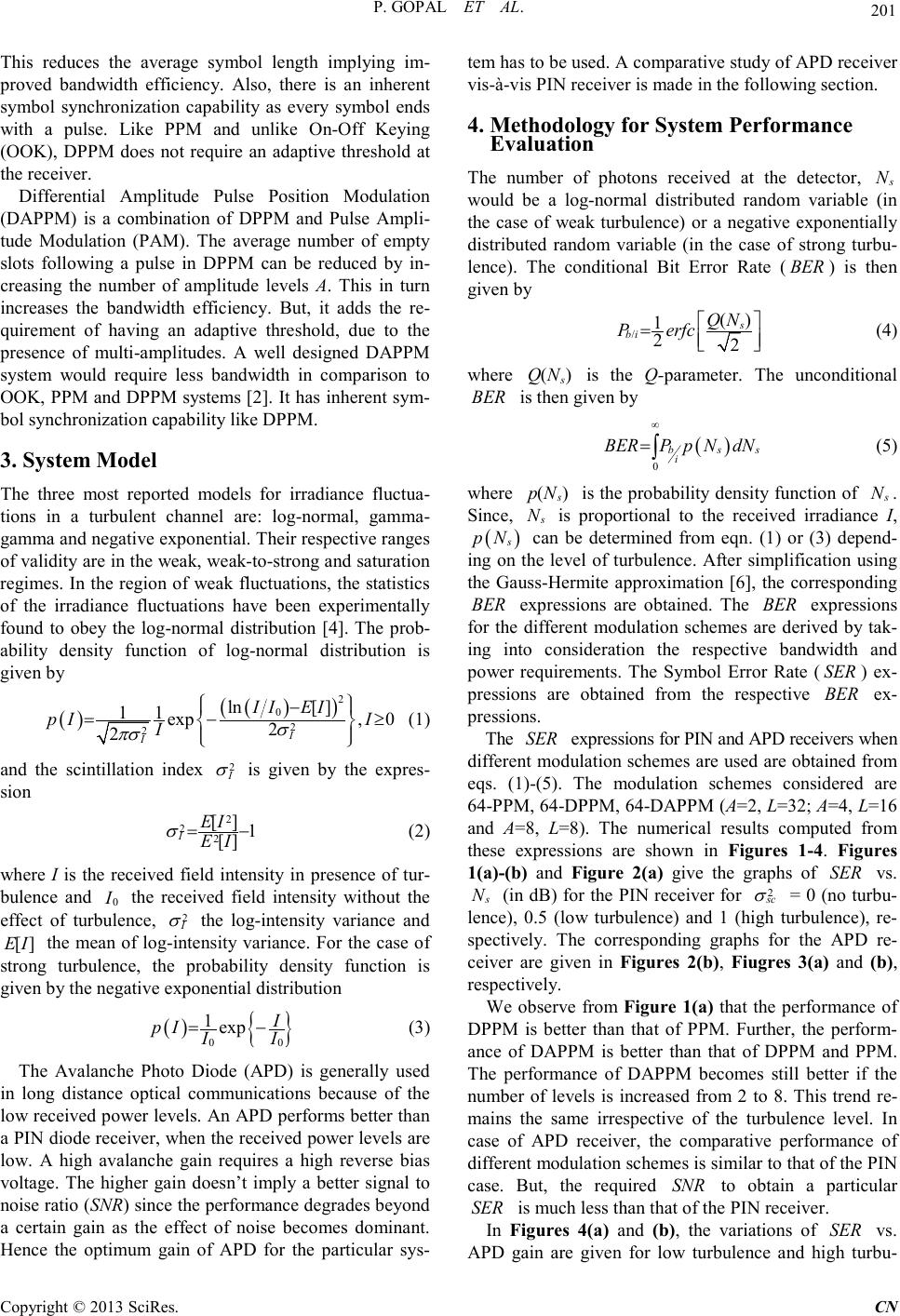
P. GOPAL ET AL.
Copyright © 2013 SciRes. CN
This reduces the average symbol length implying im-
proved bandwidth efficiency. Also, there is an inherent
symbol synchronization capability as every symbol ends
with a pulse. Like PPM and unlike On-Off Keying
(OOK), DPPM does not require an adaptive threshold at
the receiver.
Differential Amplitude Pulse Position Modulation
(DAPPM) is a combination of DPPM and Pulse Ampli-
tude Modulation (PAM). The average number of empty
slots following a pulse in DPPM can be reduced by in-
creasing the number of amplitude levels A. This in turn
increases the bandwidth efficiency. But, it adds the re-
quirement of having an adaptive threshold, due to the
presence of multi-amplitudes. A well designed DAPPM
system would require less bandwidth in comparison to
OOK, PPM and DPP M systems [2]. It has inherent sym-
bol synchronization cap a bility like DPPM.
3. System Model
The three most reported models for irradiance fluctua-
tions in a turbulent channel are: log-normal, gamma-
gamma a nd ne ga ti ve exp o ne nt ia l. T heir respective ra nge s
of validity are in the weak, weak-to-str ong a nd sa tura tio n
regimes. In the region of weak fluctuations, t he statistics
of the irradiance fluctuations have been experimentally
found to obey the log-normal distribution [4]. The prob-
ability density function of log-normal distribution is
given by
( )( )
( )
2
0
2
2
ln[ ]
11
exp, 0
2
2I
I
I IEI
pI I
I
σ
πσ
−
(1)
and the scintillation index
is given by the expres-
sion
(2)
where I is the received field intensity in presence of tur-
bulence and
the received field intensity without the
effect of turbulence,
the log-intensity variance and
the mean of log-intens ity variance. For the case of
strong turbulence, the probability density function is
given by the negative exp onential distribution
(3)
The Avalanche Photo Diode (APD) is generally used
in long distance optical communications because of the
low received power levels. An APD performs better than
a PIN diode receiver, when the received power levels are
low. A high avalanche gain requires a high reverse bias
voltage. The higher gain doesn’t imply a better signal to
noise ratio (SNR) si nce the performance degrades beyond
a certain gain as the effect of noise becomes dominant.
Hence the optimum gain of APD for the particular sys-
tem has to be used. A comparative study of APD receiver
vis-à -vis P IN receiver is made in the following sectio n.
4. Methodology for System Performance
Evaluation
The number of photons received at the detector,
would be a log-normal distributed random variable (in
the case of weak turbulence) or a negative exponentially
distributed random variable (in the case of strong turbu-
lence). The conditional Bit Error Rate (
) is then
given by
/
1
22s
bi QN
P erfc
=
(4)
where
s
QN is the Q-parameter. The unconditional
is then given by
(5)
where
s
is the probab ility density functio n of
.
Since, s
is proportional to the received irradiance I,
s
can be determined from eqn. (1) or (3) depend-
ing on the level of turbulence. After simpl ification using
the Gauss-Hermite approximation [6], the corresponding
expressions are obtained. The
expressions
for the different modulation schemes are derived by tak-
ing into consideration the respective bandwidth and
power requirements. The Symbol Error Rate (
) ex-
pressions are obtained from the respective
ex-
pressions.
The
expressions for PIN and APD receivers when
different modulation schemes are used are obtained from
eqs. (1)-(5). The modulation schemes considered are
64-PPM, 64-DPPM, 64-DAPPM (A=2, L=32; A=4, L=16
and A=8, L=8). The numerical results computed from
these expressions are shown in Figures 1-4 . Figures
1(a)-(b) and Figure 2(a) give the graphs of
vs.
s
(in dB) for the PIN receiver for
= 0 (no turbu-
lence), 0.5 (low turbulence) and 1 (high turbulence), re-
spectively. The corresponding graphs for the APD re-
ceiver are given in Figures 2(b), Fiugres 3(a) and (b) ,
respectively.
We observe from Figure 1(a) that the performance of
DPPM is better than that of PPM. Further, the perform-
ance of DAPPM is better than that of DPPM and PPM.
The performance of DAPPM becomes still better if the
number of levels is increased from 2 to 8. This trend re-
mains the same irrespective of the turbulence level. In
case of APD receiver, the comparative performance of
different modula tion sc hemes is similar to that of the P IN
case. But, the required
to obtain a particular
is muc h les s than that of the PIN receiver.
In Fig ures 4(a) and (b), the variations of
vs.
APD gain are given for low turbulence and high turbu-